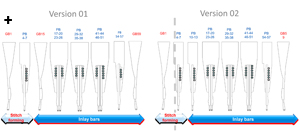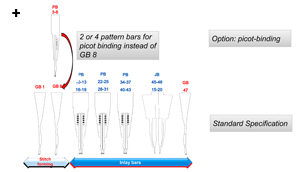
Spacer fabric lace mix from Karl Mayer
According to raschel lace machine builder Karl Mayer, lace belongs to the ‘must have accessories of female charm, appearing in the same diversity as women themselves'. The German company says that nevertheless, the manufacture of these delicate and seductive articles not only requires a filigree design but also the highest efficiency, requireme

22nd August 2011
Knitting Industry
|
Obertshausen
According to raschel lace machine builder Karl Mayer, lace belongs to the ‘must have accessories of female charm, appearing in the same diversity as women themselves'. The German company says that nevertheless, the manufacture of these delicate and seductive articles not only requires a filigree design but also the highest efficiency, requirements which result in a continuous upgrading of the technical perfection of the production equipment used.
Karl Mayer is launching four new models which aim to complete the successful ML and JL machine series and the innovations are said to be designed to produce simple trimmings (lace edgings) with exceptionally high productivity.
The company says that when compared to conventional production technologies, the high efficiency of the new machine types ensures the same output although the machines require less space, or in case of the same floor space requirement the machines offer higher performance.
"The small footprint of the new models gives especially long-established, urban companies with reduced expansion possibilities the chance to make great leaps forward. Besides, the innovative ML and JL types are best suited for large-scale production markets," a Karl mayer spokesperson said.
 ML 34 and ML 46 Multibar Lace machines
ML 34 and ML 46 Multibar Lace machinesAccording to Karl Mayer, the newcomers of the ML series combine the basic technical features of the Multibar Lace machine with Karl Mayer's latest innovations in the sector of raschel lace machines.
"The replacement of the old systems based on chain links and SU drives by the extremely successful string bar concept, theKAMCOS computer platform with Multi Speed, the electronic control systems for yarn feeding and patterning as well as features such as the Positive Pattern Beam Drive (PPD) for active pattern yarn feeding result in a considerably increased efficiency of the newly developed machine types - at an exceptionally favourable price," Karl Mayer says adding:
"By means of Karl Mayer's clever location policy focusing on the core-part production in Germany as essential aspect of the company's strategy, the two additional types of the Multibar Lace machine range offer a clearly improved price-performance ratio, compared to their predecessors."
 The two Multibar raschel machines are available in gauges of E 24 and E 28, operate at a working width of 134 inches and have maximum speed of 900 rpm. Being based on the same machine platform, they mainly differ by their bar configuration. The arrangement of the bars can be seen in Figs. 1 and 2.
The two Multibar raschel machines are available in gauges of E 24 and E 28, operate at a working width of 134 inches and have maximum speed of 900 rpm. Being based on the same machine platform, they mainly differ by their bar configuration. The arrangement of the bars can be seen in Figs. 1 and 2.
As an optional feature, the GB 2 can be replaced by two to four pattern guide bars for producing picot bindings or additional inlay laps (weft laps). In addition, upon request, it is also possible to use one ground guide bar for working another inlay lap.
The ML 46 also offers the possibility to replace the first of the two rear ground guide bars by four additional pattern guide bars. By increasing the number of pattern guide bars compared to its low bar counterpart, the ML 46 can produce designs with even more sophisticated motifs as well as wider lace bands next to one another, Karl Mayer says.
"The ML 46 will be available as from the second quarter of 2012 and the ML 34 at the beginning of next year. Once all the machines have been introduced to the market, the new generation of the Multibar Lace will also include the ML 35 C type, following the company's known segmentation," Karl Mayer explains.
First reactions to the innovations are said to have already been very favourable and Asian manufacturers in particular are said to be highly interested in the machines for their unique efficiency and top product quality.
 JL 29/1 B and JL 83/1 B Jacquardtronic Lace machines
JL 29/1 B and JL 83/1 B Jacquardtronic Lace machinesThe new JL 29/1 B is based on the concept of the JL 42/1 machine but Karl Mayer says it differs from the high-speed model of the Jacquardtronic series by its specific price-performance ratio. Contrary to the JL 42/1 type, the newcomer operates with a reduced number of pattern guide bars at almost identical maximum rotational speeds, compensating for the reduction by less investment costs.
Fig. 3 shows the standard configuration of the JL 29/1 B machine. Optionally to the standard configuration it is possible to replace the second of the two front ground guide bars by two to four pattern guide bars and additionally all the pattern beam positions can be equipped with a Positive Pattern Beam Drive (PPD), extending the design possibilities. Other features of the JL 29/1 B machine are a working width of 132 inches plus 2-inch extension of the stentering selvedge, gauges of E 24 and E 28, the KAMCOSsystem, an electronically controlled yarn feeding system and an electronic guide bar drive.
Karl Mayer says this profile makes the new Jacquardtronic Lace machine best suited for the efficient production of elastic and rigid lace bands as well as all-over lace fabrics with simple, unsophisticated and straight designs - in connection with the low investment costs just the right machine for new starters and manufacturers of standard articles in large-scale production. The first buying options have already been registered in the second quarter of this year.
"As a valuable addition to the JL series, Karl Mayer completed its successful JL 83/1 machines by a B variant. The arrangement of the Jacquard bar at the rear position, seen from the knitter's position, results in a patterning with raised design elements that stand out against the fabric ground with amazing clarity," Karl Mayer says.

Business intelligence for the fibre, textiles and apparel industries: technologies, innovations, markets, investments, trade policy, sourcing, strategy...
Find out more